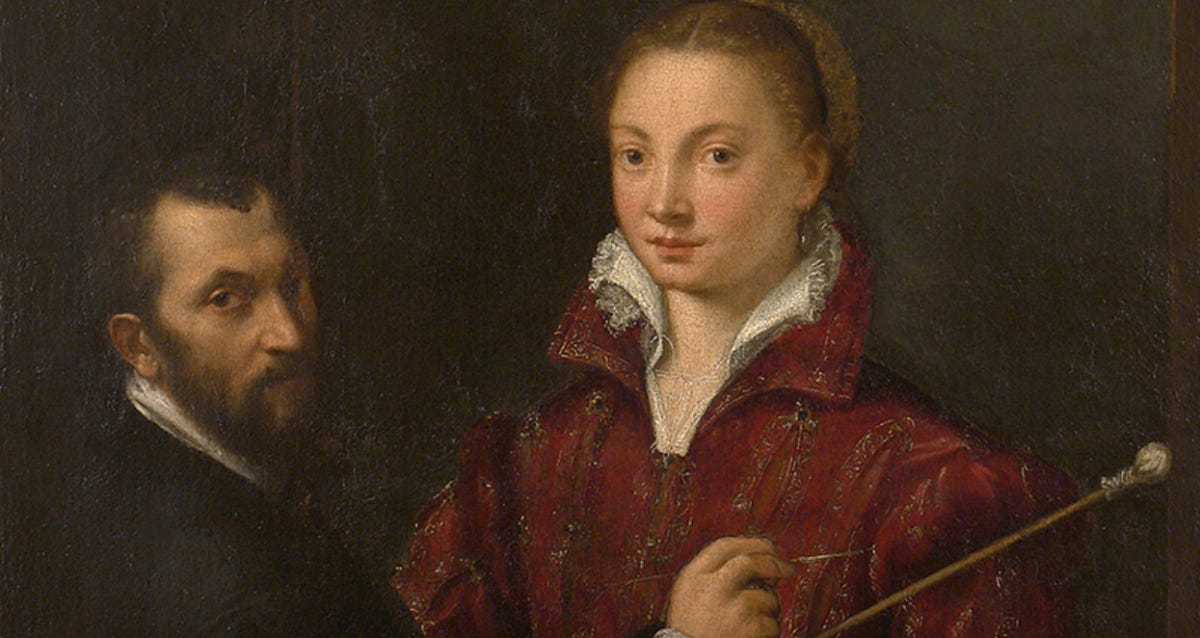Brat summer is over. Make way for Renaissance autumn.
Why I’m taking inspo from a Dominican nun and the first ever romance writer this season.
I’ve got nothing against Brat per se, but, since it’s over anyway (as CharlieXCX has herself declared), I’m ready for Renaissance Fall/Autumn. Who’s with me?
A neon green light flickers in the dusty haze of summer memories: a signal Brat summer is well and truly over.
It was wild, wasn’t it?
Or not, depending on your brand of Brat. That was the point.
In the “it” movement of 2024, we saw CharlieXCX’s beats of hedonism blow their way, one “pack of cigs” at a time, through public consciousness. First a Tiktok trend, Brat seeped into wider pop culture before finally reaching the political sphere. It promised unabashed acceptance and unapologetic selfhood.
Brat is not a brat is not a brat.
Unlike its usurper, the very demure, very mindful trend, Brat wasn’t posed as a state towards which you could (or should) strive. Rather, Brat was a house party down the road to which you were invited, sure, but who cared if you bothered to go? You did you… and you did it however you wanted. As The Guardian’s Zoe Williams wrote back in July, “It’s not a feminine ideal, brat, because it rejects the social surveillance that requires all young women to be the same way.”
Online Brat commentary described the movement as being “as loud about your insecurities as you are about your accomplishments” in an “active self-consciousness that’s refreshingly frank, not unlike a toddler’s tantrum.” When CharlieXCX was asked what was needed to have a Brat summer in a Radio 1 interview, the Queen of the Brat Pack replied, “It can go that way, like, quite luxury, but it can also be so, like, trashy. Just, like, a pack of cigs, and, like, a Bic lighter, and, like, a strappy white top. With no bra. That's, like, kind of all you need.”
For a movement at pains to style itself as unstyled, that’s a pretty prescriptive aesthetic. And words like “active” and “frank” suggest a mould more suited to an outgoing personality; a type who doesn’t fear brashness. Perhaps more telling is the comparison to a “temper tantrum” – this feels very public, very outwardly possessed, arguably, very performative.
Is this not missing the point? Is there really a need to label the simplicity of “being oneself” in 2024? Should this not be the norm, already? And, if not, should we be doing better than temper tantrums and Bic lighters?
This is where my thoughts about Brat began and ended about a week ago. And they certainly weren’t at the forefront of my mind when I settled down to read Jill Burke’s (excellent) How To Be A Renaissance Woman. Because, what has Brat got to do with the Renaissance?
The typical Renaissance woman had a lot to be brattish about. Nobody needs me to go into the systemic, legal and religious misogyny that shackled the average woman every day. In fact, it would have been reasonable for any woman to have thrown a braless* temper tantrum in the face of her male oppressors. At first glance, it would be easy to cast a lot of what we now call Feminist Renaissance Women as Brat. Let’s see.
Many FRWs were painters, writers and musicians, so, let us look at a verse from fellow purveyor of the arts Charlie XCX:
Yeah, it's 4 a.m., and she's out there
With the razor-sharp tongue stuck to skinny cigarettes
Calls him Daddy while she's fingering a gold cross
And she's kinda f*cked up, but she's still in Vogue
Yeah, she's in her mid-twenties, real intelligent
And you hate the fact she's New York City's darling
You said she's problematic and the way you say it, so fanatic
Think she already knows that you're obsessed
(second verse from Mean girls, the Brat album)
I like this for a lot of reasons. I can get on board with the “real intelligent despite perception” narrative. I also like the way CharlieXCX describes her subject as having a “razor-sharp” tongue, denoting wit, and how she depicts this woman’s haters as mere “fanatics” who have nothing better to talk about. So far, Brat proves to be a useful and disarming position. There is, however, one bothersome line:
“And she’s kinda f*cked up, but she’s still in Vogue”
This worries me in two ways. The first is out of sympathy for this woman: why is she f*cked up? Is she okay? Perhaps being in Vogue is not good for her at the moment, nor being in the public eye?
The second is how it twists the verse as a whole. Now that I know this person is struggling mentally and internally, I cannot cheer from the sidelines to the “haha, joke’s on you – you love to hate her and that’s to her benefit” argument. It’s not to her benefit, is it? She is f*cked up, yet, putting on a brave face for Vogue because she thinks this is the only way to get back at her naysayers. This sounds like a horrible situation to be in.
It may sound twee, but this version of Brat ignores what’s happening on the inside. It’s the aesthetic that matters, what people think that matters, the revenge stance that matters… but not the internal monologues and self-esteem (real self-esteem, not the performative kind). I am certain that Giulia Bigolina (1518-1569), author of the first ever romance novel, Urania, would have some thoughts.
Urania starts as all good romance stories do:
Urania, our heroine, is in a mess. She’s been rejected by the love of her life, Fabio, for someone “much more beautiful than her, but faded in comparison to her virtue” and must somehow find a way forward. Urania’s adventures begin after she flees her hometown, dressed in men’s clothing, to travel Italy: she advises a group of women on how to find a decent husband and launches into a full scale defence of the female to a group of men. Fabio eventually realises he’s made a mistake and learns that looks are not as important as character.
To a modern reader, this story isn’t the most empowering of tales (we’re accustomed to genre romance by now), but put yourself in the shoes of a Renaissance woman and it begins to spin a little differently. Here, the first woman to write a prose romance has focused not on exterior beauty (something Renaissance culture was obsessed by), but internal virtue and contentment. Urania, like CharlieXCX’s subject, is “f*cked up” as she begins her adventure. However, instead of continuing to perform in a way that is detrimental to her well-being to gain points, she holds internal virtue above all else:
“There are two beauties in women loved and desired by men – that is, the beauty of the body and the beauty of the soul – and the incorruptible and immortal nature of one, and the corruptible and fleeting nature of the other, make clear how much the one must be kept dearer and more esteemed than the other.”*
Religious undertones aside, I can’t help but feel that CharlieXCX’s New York darling might find more peace if she held her mental health in more esteem than her outwardly staged “give a f*ck” attitude, which she hopes people will obsess over. She seeks power from outside perception, something she will never control, rather than internal resolution.
Of course, Urania and the subject of Mean girls is not a perfect comparison – “virtue” is not synonymous with “mental well-being”. However, it’s a first step toward looking at how the Renaissance women who sought independence and fairness placed themselves – their minds, their thoughts, their health – as a priority in their stance against the patriarchy. This is at odds with Brat, which relies on the perception of others to gain traction.
Visual culture fuelled Brat summer as much as its rhetoric. The neon green of Charlie XCX’s album became a symbol of Brat, its garish shade dominating TikTok and Instagram feeds.
If anyone understood the power of visual culture, it was the female painters of the Renaissance. One that springs to mind is the Florentine Dominican nun, Plautilla Nelli (1524-88). In Katy Hessel’s immensely popular The Story of Art Without Men we see she was a very accomplished miniaturist painter before working on large altarpieces – a rare feat for a woman in her day. Hessel writes, “As a woman, Nelli wasn’t supposed to take on the challenge of large-scale paintings, but she did it anyway.”
Nelli is best known for her Last Supper (1560) which is the first known depiction of a biblical tale by a woman. This would likely have been completed in the all-women workshop she set up in her convent and, perhaps, the nuns would have posed for the painting.
As a result of undeniable skill, Nelli is one of only four women to feature in Vasari’s The Lives of Artists. In the spirit of “doing it anyway”, Nelli subverted gender norms and commanded respect by subtle visual warfare. She worked fastidiously and carefully until she became better than her male counterparts. This is the opposite of wearing Brat green, which draws the eye due to shock factor. Nelli, instead, placed her talents and skill at the centre of discussion.
The same can be said for Sofonisba Anguissola (1535-1625). Having trained under local painter Bernardino Campi, she produced many stunning self-portraits (one of which is shown above). Self-portraits were a common output for female painters and this is usually put down to the fact that women weren’t technically allowed to paint other subjects (although, as we’ve seen, our nun Nelli did). Burke suggests this is a dismissive take and I agree: self-portraits allowed women to take control of their image. Whether this took the form of signing self-portraits as ‘virgo’ (‘virgin’, as Anguissola did with her earlier portraits), or showing the world who was boss in a marvellous display of power balance (see Self-Portrait with Bernardino Campi (1550)), women painters fought through skilled and complex imagery to change their perception.
That’s not Brat. It’s quiet. It’s self-centred in the truest sense. It performs but doesn’t pander. It demands individual respect through subtle association, not mass disassociation.
I’ve got nothing against Brat per se, but, since it’s over anyway (as CharlieXCX has herself declared), I’m ready for Renaissance Fall/Autumn. Who’s with me?
*One of my favourite facts in HTBARW is that “breast bags”, or bras, were actually a 15th century invention, contrary to previous opinion.
*Bigolina, Urania: A Romance, trans. And ed. Valeria Finnucci (2007), 89.
I want to make sure you receive precisely what you want from me. If this post is your jam, then you may also enjoy ‘Writing in buildings’ and ‘Fiction in the reading room’.
If you originally subscribed to read my serialised mystery, Cold Secrets, and only want to receive these weekly Saturday chapters, then select "Unsubscribe" in the footer of this email and click on "Turn off emails" next to each section you'd like to unsubscribe from.







“That’s not Brat. It’s quiet. It’s self-centred in the truest sense. It performs but doesn’t pander. It demands individual respect through subtle association, not mass disassociation.” Loved this! Great job!
What a fabulous read